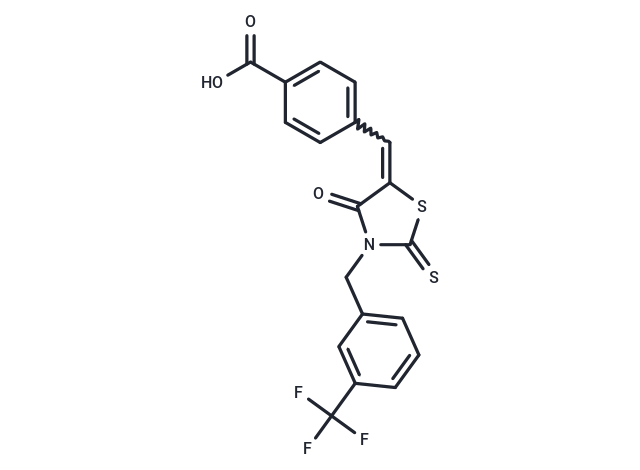Shopping Cart
Remove All Your shopping cart is currently empty
Your shopping cart is currently empty
CY-09 is an NLRP3 inhibitor.

| Pack Size | Price | USA Warehouse | Global Warehouse | Quantity |
|---|---|---|---|---|
| 2 mg | $55 | In Stock | In Stock | |
| 5 mg | $68 | In Stock | In Stock | |
| 10 mg | $118 | In Stock | In Stock | |
| 25 mg | $247 | In Stock | In Stock | |
| 50 mg | $392 | In Stock | In Stock | |
| 100 mg | $589 | In Stock | In Stock | |
| 500 mg | $1,330 | Inquiry | Inquiry |
| Description | CY-09 is an NLRP3 inhibitor. |
| In vitro | CY-09 demonstrates a dose-dependent decrease in monosodium urate (MSU), nigericin, and ATP-triggered caspase-1 activity and IL-1β release across 1 to 10 μM concentrations in LPS-primed bone marrow-derived macrophages (BMDMs). It effectively prevents cytosolic LPS-induced noncanonical NLRP3 activation in BMDMs. Notably, CY-09, like MCC950, selectively curbs NLRP3 inflammasome activity without impacting LPS-induced priming effects. Additionally, CY-09 significantly hinders nigericin-induced ASC oligomerization and disrupts Flag-NLRP3 and mCherry-NLRP3 interactions in HEK-293T cells, indicating a blockage of NLRP3 oligomerization by CY-09. |
| In vivo | Compare with MCC950, CY-09 treatment?in vivo?efficiently suppresses monosodium urate (MSU) injection-induced IL-1β production and neutrophil influx, suggesting that CY-09 can block MSU-induced NLRP3 inflammasome activation?in vivo. CY-09 treatment also increases the survival of?NLRP3mutant mice up to days 30 to 48 even after treatment is stopped at day 25. The caspase-1 cleavage observed in adipose tissue of HFD-treated mice is also suppressed by CY-09 |
| Kinase Assay | For ATPase activity assay, purified recombinant human proteins are incubated at 37°C with indicated concentrations of CY-09 for 15 min in the reaction buffer. ATP (25 μM) is then added, and the mixture is further incubated at 37°C for another 40 min. The amount of ATP converted into adenosine diphosphate (ADP) is determined by luminescent ADP detection with ADP-Glo Kinase Assay kit according to the manufacturer's protocol. The results are expressed as percentage of residual enzyme activity to the vehicle-treated enzyme. For ATP binding assay, purified NLRP3 proteins are incubated with ATP binding agarose for 1 h and then different concentrations of CY-09 are added and incubated for 2 h with motion at 4°C. Beads are washed and boiled in loading buffer. Samples are subjected to immunoblotting analysis[1]. |
| Cell Research | To induce NLRP3 inflammasome activation, 5×105/mL BMDMs and 6×106/mL PBMCs are plated in 12-well plates. The following morning, the medium is replaced, and cells are stimulated with 50 ng/mL LPS or 400 ng/mL Pam3CSK4 (for noncanonical inflammasome activation) for 3 h. After that, CY-09 or other inhibitors are added into the culture for another 30 min, and then the cells are stimulated for 4 h with monosodium urate (MSU) (150 μg/mL),?Salmonella typhimurium?(multiplicity of infection) or for 30 min with ATP (2.5 mM) or nigericin (10 μM). Cells are transfected with poly(dA:dT) (0.5 μg/mL) for 4 h or LPS (500 ng/mL) overnight. Cell extracts and precipitated supernatants are analyzed by immunoblot[1]. |
| Animal Research | For the?in vivo?experiments, CY-09 is formulated in a vehicle containing 10% DMSO, 10% Solutol HS 15, and 80% saline,WT or Nlrp3?/? mice at the age of 6 wk, with similar plasma glucose levels and body weights are randomized into different groups. For generation of high-fat diet (HFD)-induced diabetic mice, mice are fed with HFD for 14 wk. The diabetic mice are treated with CY-09 (i.p.) at a dose of 2.5 mg/kg once a day for 6 wk. The mice are maintained with HFD when used for CY-09 treatment and the subsequent experiments[1]. |
| Synonyms | CY 09 |
| Molecular Weight | 423.43 |
| Formula | C19H12F3NO3S2 |
| Cas No. | 1073612-91-5 |
| Smiles | OC(=O)c1ccc(C=C2SC(=S)N(Cc3cccc(c3)C(F)(F)F)C2=O)cc1 |
| Relative Density. | no data available |
| Storage | store at low temperature | Powder: -20°C for 3 years | In solvent: -80°C for 1 year | Shipping with blue ice/Shipping at ambient temperature. | |||||||||||||||||||||||||||||||||||
| Solubility Information | DMSO: 77 mg/mL (181.85 mM), Sonication is recommended. | |||||||||||||||||||||||||||||||||||
| In Vivo Formulation | 10% DMSO+40% PEG300+5% Tween 80+45% Saline: 2 mg/mL (4.72 mM), Sonication is recommended. Please add the solvents sequentially, clarifying the solution as much as possible before adding the next one. Dissolve by heating and/or sonication if necessary. Working solution is recommended to be prepared and used immediately. The formulation provided above is for reference purposes only. In vivo formulations may vary and should be modified based on specific experimental conditions. | |||||||||||||||||||||||||||||||||||
Solution Preparation Table | ||||||||||||||||||||||||||||||||||||
DMSO
| ||||||||||||||||||||||||||||||||||||
| Size | Quantity | Unit Price | Amount | Operation |
|---|

Copyright © 2015-2025 TargetMol Chemicals Inc. All Rights Reserved.